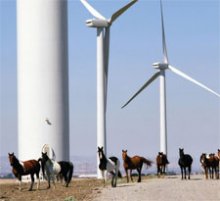Wind Turbine Environmental Issues
|
Wind energy development environmental concerns include, noise, visual impacts, and avian and bat mortality. Although wind power plants have relatively little impact on the environment compared to fossil fuel power plants, concerns have been raised over the noise produced by the rotor blades, visual impacts, and deaths of birds and bats that fly into the rotors (avian/bat mortality). These and other concerns associated with wind energy development are discussed below, and are addressed in the Wind Energy Development Programmatic EIS. To get more information about these concerns and access current research, please visit the suggested web sites listed on the Wind Energy Links page. NoiseLike all mechanical systems, wind turbines produce some noise when they operate. Most of the turbine noise is masked by the sound of the wind itself, and the turbines run only when the wind blows. In recent years, engineers have made design changes to reduce the noise from wind turbines. Early model turbines are generally noisier than most new and larger models. As wind turbines have become more efficient, more of the wind is converted into rotational torque and less into acoustic noise. Additionally, proper siting and insulating materials can be used to minimize noise impacts. Visual ImpactsBecause they must generally be sited in exposed places, wind turbines are often highly visible; however, being visible is not necessarily the same as being intrusive. Aesthetic issues are by their nature highly subjective. Proper siting decisions can help to avoid any aesthetic impacts to the landscape. One strategy being used to partially offset visual impacts is to site fewer turbines in any one location by using multiple locations and by using today's larger and more efficient models of wind turbines. Avian/Bat MortalityBird and bat deaths are one of the most controversial biological issues related to wind turbines. The deaths of birds and bats at wind farm sites have raised concerns by fish and wildlife agencies and conservation groups. On the other hand, several large wind facilities have operated for years with only minor impacts on these animals. To try to address this issue, the wind industry and government agencies have sponsored research into collisions, relevant bird and bat behavior, mitigation measures, and appropriate study design protocols. In addition, project developers are required to collect data through monitoring efforts at existing and proposed wind energy sites. Careful site selection is needed to minimize fatalities and in some cases additional research may be needed to address bird and bat impact issues. While structures such as smokestacks, lighthouses, tall buildings, and radio and television towers have also been associated with bird and bat kills, bird and bat mortality is a serious concern for the wind industry. Other ConcernsUnlike most other generation technologies, wind turbines do not use combustion to generate electricity, and hence don't produce air emissions. The only potentially toxic or hazardous materials are relatively small amounts of lubricating oils and hydraulic and insulating fluids. Therefore, contamination of surface or ground water or soils is highly unlikely. The primary health and safety considerations are related to blade movement and the presence of industrial equipment in areas potentially accessible to the public. An additional concern associated with wind turbines is potential interference with radar and telecommunication facilities. And like all electrical generating facilities, wind generators produce electric and magnetic fields. |









